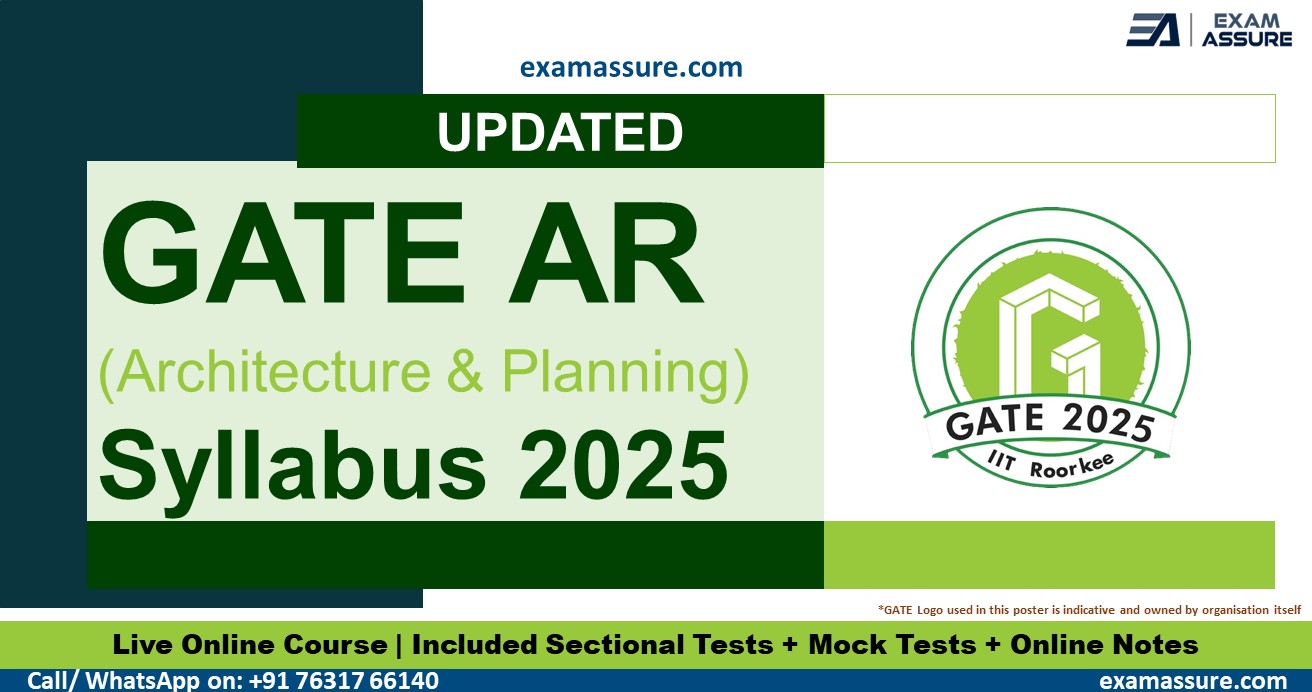GATE Architecture Syllabus 2025 | GATE Architecture and Planning Syllabus 2025 | GATE AR & PL Updated Syllabus 2025 | GATE Ar Syllabus 2025
Exam Assure updates regularly on WhatsApp
Join WhatsApp Group
Join us on Social media:

GATE Architecture Syllabus 2025 | GATE Architecture and Planning Syllabus 2025 | GATE AR & PL Latest Syllabus 2025
The GATE Architecture and Planning Paper consists of two Sections: General Aptitude (15 Marks) and Technical Section (Architecture and Planning) (85 Marks). The Technical Section is divided into two parts: Part A: Common and Part B. Part B is further divided into two different parts: Part B1: Architecture and Part B2: Planning.
Part A is common for all candidates however Candidates will get the option to choose from
Part B1: Architecture and Part B2: Planning.
| S.No. | Section: | Total Marks: |
| 1. | General Aptitude | 15 Marks |
| 2. | Technical Section (Architecture and Planning) | 85 Marks |
| Total Marks: | 100 Marks |
Syllabus Overview of GATE AR 2025
A. General Aptitude (15 Marks)
1. Verbal Aptitude
2. Quantitative Aptitude
3. Analytical Aptitude
4. Spatial Aptitude
AR. Architecture and Planning
Part A: Common (60 Marks)
Section 1: Architecture, Planning and Design
Section 2: Construction and Management
Section 3: Environmental Planning and Design
Section 4: Urban Design, Landscape and Conservation
Section 5: Planning process
Section 6: Housing
Section 7: Services and Infrastructure
Part B1: Architecture (25 Marks)
Section B1.1: History and Contemporary Architecture
Section B1.2: Building Construction and Structural systems
Section B1.3: Building Services and Sustainability
Part B2: Planning (25 Marks)
Section B2.1: Regional and Settlement Planning
Section B2.2: Planning Techniques and Management
Section B2.3: Infrastructure Planning
Detailed Syllabus of GATE 2025
A. General Aptitude
1. Verbal Aptitude
Basic English grammar: tenses, articles, adjectives, prepositions, conjunctions, verb-nounagreement, and other parts of speech Basic vocabulary: words, idioms, and phrases incontext Reading and comprehension Narrative sequencing
2. Quantitative Aptitude
Data interpretation: data graphs (bar graphs, pie charts, and other graphs representingdata), 2-and 3-dimensional plots, maps, and tables Numerical computation and estimation: ratios,percentages, powers, exponents and logarithms, permutations and combinations, andseriesMensuration and geometry Elementary statistics and probability
3. Analytical Aptitude
Logic: deduction and induction, Analogy, Numerical relations and reasoning
4. Spatial Aptitude
Transformation of shapes: translation, rotation, scaling, mirroring, assembling, and grouping Paper folding, cutting, and patterns in 2 and 3 dimensions
AR. Architecture and Planning
Part A: Common
Section 1: Architecture, Planning and Design
Architectural Graphics; Visual composition in 2D and 3D; Computer application in Architecture and Planning; Anthropometrics; Organization of space; Circulation- horizontal and vertical; Space Standards; Universal design; Building byelaws; Codes and standards;
Section 2: Construction and Management
Project management techniques e.g. PERT, CPM etc.; Estimation and Specification; Professional practice and ethics; Form and Structure; Principles and design of disaster resistant structures; Temporary structures for rehabilitation;
Section 3: Environmental Planning and Design
Natural and man-made ecosystem; Ecological principles; Environmental considerations in Planning and design; Environmental pollution- types, causes, controls and abatement strategies; Sustainable development, goals and strategies; Climate change and built environment; Climate responsive design;
Section 4: Urban Design, Landscape and Conservation
Historical and modern examples of urban design; Elements of urban built environment – urban form, spaces, structure, pattern, fabric, texture, grain etc.; Concepts and theories of urban design; Principles, tools and techniques of urban design; Public spaces, character, spatial qualities and Sense of Place; Urban design interventions for sustainable development and transportation; Development controls – FAR, densities and building byelaws.; Urban renewal and conservation; heritage conservation; historical public spaces and gardens; Landscape design; Site planning;
Section 5: Planning process
Salient concepts, theories and principles of urban planning; concepts of cities – Eco-City, Smart City; Concepts and theories by trendsetting planners and designers; Ekistics; Urban sociology; Social, Economic and environmental cost benefit analysis; Methods of non-spatial and spatial data analysis; Development guidelines such as URDPFI;
Section 6: Housing
Housing typologies; Concepts, principles and examples of neighbourhood; Residential densities; Affordable Housing; Real estate valuation;
Section 7: Services and Infrastructure
Firefighting Systems; Building Safety and Security systems; Building Management Systems; Water treatment; Water supply and distribution system; Water harvesting systems; Principles, Planning and Design of storm water drainage system; Sewage disposal methods; Methods of solid waste management – collection, transportation and disposal; Recycling and Reuse of solid waste; Land-use – transportation – urban form inter-relationships; Design of roads, intersections, grade separators and parking areas; Hierarchy of roads and level of service; Para-transits and other modes of transportation, Pedestrian and slow moving traffic planning;
Part B1: Architecture
Section B1.1: History and Contemporary Architecture
Principles of Art and Architecture; World History of Architecture: Egyptian, Greco-Roman classical period, Byzantine, Gothic, Renaissance, Baroque-Rococo, etc.; Recent trends in Contemporary Architecture: Art nouveau, Art Deco, Eclecticism, International styles, Post Modernism, Deconstruction in architecture, etc.; Influence of Modern art and Design in Architecture; Indian vernacular and traditional Architecture, Oriental Architecture; Works of renowned national and international architects;
Section B1.2: Building Construction and Structural systems
Building construction techniques, methods and details; Building systems and prefabrication of building elements; Principles of Modular Coordination; Construction planning and equipment; Building material characteristics and applications; Principles of strength of materials; Alternative building materials; Foundations; Design of structural elements with different materials; Elastic and Limit State design; Structural systems; Principles of Pre-stressing; High Rise and Long Span structures, gravity and lateral load resisting systems;
Section B1.3: Building Services and Sustainability
Solar architecture; Thermal, visual and acoustic comfort in built environments; Natural and Mechanical ventilation in buildings; Air-Conditioning systems; Sustainable building strategies; Building Performance Simulation and Evaluation; Intelligent Buildings; Water supply; Sewerage and drainage systems; Sanitary fittings and fixtures; Plumbing systems; Principles of internal and external drainage system; Principles of electrification of buildings; Elevators and Escalators – standards and uses;
Part B2: Planning
Section B2.1: Regional and Settlement Planning
Regional delineation; settlement hierarchy; Types and hierarchy of plans; Various schemes and programs of central government; Transit Oriented Development (TOD), SEZ, SRZ etc.; Public Perception and user behaviour; National Housing Policies, Programs and Schemes.; Slums, Squatters and informal housing; Standards for housing and community facilities; Housing for special areas and needs;
Section B2.2: Planning Techniques and Management
Application of G.I.S and Remote Sensing techniques in urban and regional planning; Tools and techniques of Surveys – Physical, Topographical, Land use and Socio-economic Surveys; Urban Economics, Law of demand and supply of land and its use in planning; Graphic presentation of spatial data; Local self-governance, Panchayatiraj institutions; Planning Legislation and implementation – Land Acquisition Act, PPP etc.; Decision support system and Land Information System; Urban geography and econometrics; Management of Infrastructure Projects; Demography and equity in planning;
Section B2.3: Infrastructure Planning
Process and Principles of Transportation Planning and Traffic Engineering; Road capacity and Travel demand forecasting; Traffic survey methods, Traffic flow Analysis; Traffic analyses and design considerations; Traffic and transport management and control in urban areas; Mass transportation planning; Intelligent Transportation Systems; Urban and Rural Infrastructure System Network.
Online Classes for
GATE AR 2026 | DSSSB Vacancies @ NDMC & DUSIB
Hope you liked this
Recent Government Jobs:
- Vacancy for Multiple Positions (Director, Dy. Director & Assistant Director) at Council of Architecture (COA) | Posting Location: Delhi/Bhopal/Pune/Bangalore (Last Date : 30 April 2025)
- Vacancy for ESTIMATOR / QUANTITY ENGINEER at Lucknow Development Authority (LDA, Lucknow) | Posting Location: Uttar Pradesh (Walk-in-Interview : 16 April 2025) – Civil Engineering Job
- Vacancy for Town Planner/Urban Planner at Chennai Unified Metropolitan Transport Authority (CUMTA) | Posting Location: Chennai, Tamil Nadu (Last Date: 30 April 2025)
- Vacancy for Assistant Managers at Dholera Industrial City Development Limited (DICDL) | Posting Location: Dholera, Gujarat (Last Date : 23 April 2025)
Visit Exam Assure Jobs Section to explore similar Jobs:
Disclaimer: The Job posts/ Job vacancies updated on the Exam Assure platform are gathered from various sources. Exam Assure team tries their best to display correct information as far as possible however there is a chance of mistakes. Visitors are suggested to cross-verify all the information before applying.







